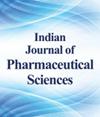Formulation and Optimization of Propranolol Bilayer Tablets: A Potential Approach for Effective Management of Hypertension
IF 0.4
4区 医学
Q4 PHARMACOLOGY & PHARMACY
Indian Journal of Pharmaceutical Sciences
Pub Date : 2023-01-01
DOI:10.36468/pharmaceutical-sciences.1081
引用次数: 0
Abstract
The purpose of this investigation is to formulate and evaluate the antihypertensive drug propranolol hydrochloride sustained-release bilayer tablets. In this formulation, one layer provides a loading dose through the immediate release of the drug and the other layer provides a maintenance dose for up to 12 h through controlled release. Different quantities of polymers such as Kyron T-314, Hydroxypropyl methylcellulose-K4M, and ethyl cellulose were used to make bi-layer tablets by direct compression. The compatibility study of pharmaceutical excipients was conducted through Fourier transform infrared spectroscopy studies and no interaction was found. The pre-compression parameter for the angle of repose, bulk density, tapped density and compressibility index was assessed on the produced granules and the findings were good. The tablets were evaluated for the post-compression parameters for thickness, hardness, friability and in vitro release studies. In vitro dissolution study was approved out for 12 h using United States Pharmacopeia dissolution apparatus I using phosphate buffer of pH 1.2 and 6.8 as dissolution medium. Hydroxypropyl methylcellulose-K4M and ethylcellulose were used in combination in all formulations but optimized formulation propranolol hydrochloride tablet 4 showed a higher rate of drug release up to 12 h as compared to the other formulation and optimized formulations propranolol hydrochloride tablet 4 follows the Higuchi model with non-fickian diffusion based on regression coefficient of the kinetics data of cumulative drug release from the dosage form.心得安双层片的处方与优化:有效治疗高血压的潜在途径
本研究的目的是研制降压药盐酸心得安缓释双层片并对其进行评价。在该配方中,一层通过药物的立即释放提供负载剂量,另一层通过控释提供长达12小时的维持剂量。使用不同数量的聚合物,如Kyron T-314、羟丙基甲基纤维素- k4m和乙基纤维素,通过直接压缩制成双层片。通过傅里叶变换红外光谱研究了药用辅料的配伍性,未发现相互作用。对生产的颗粒进行了休止角、容重、攻丝密度、压缩系数等预压缩参数的评价,结果良好。对片的厚度、硬度、脆度和体外释放度进行压缩后评价。采用美国药典溶出仪I,以pH为1.2和6.8的磷酸盐缓冲液为溶出介质,进行12 h的体外溶出研究。各剂型均采用羟丙基甲基纤维素- k4m与乙基纤维素复合,但优化后的盐酸心得洛尔片4在12 h内的释药速率高于其他剂型,且基于剂型累积释药动力学数据的回归系数,优化后的盐酸心得洛尔片4符合非菲克扩散的Higuchi模型。
本文章由计算机程序翻译,如有差异,请以英文原文为准。
求助全文
约1分钟内获得全文
求助全文
来源期刊

Indian Journal of Pharmaceutical Sciences
PHARMACOLOGY & PHARMACY-
自引率
0.00%
发文量
0
审稿时长
2 months
期刊介绍:
The Indian Journal of Pharmaceutical Sciences (IJPS) is a bi-monthly Journal, which publishes original research work that contributes significantly to further the scientific knowledge in Pharmaceutical Sciences (Pharmaceutical Technology, Pharmaceutics, Biopharmaceutics, Pharmacokinetics, Pharmaceutical/Medicinal Chemistry, Computational Chemistry and Molecular Drug Design, Pharmacognosy and Phytochemistry, Pharmacology and Therapeutics, Pharmaceutical Analysis, Pharmacy Practice, Clinical and Hospital Pharmacy, Pharmacovigilance, Pharmacoepidemiology, Pharmacoeconomics, Drug Information, Patient Counselling, Adverse Drug Reactions Monitoring, Medication Errors, Medication Optimization, Medication Therapy Management, Cell Biology, Genomics and Proteomics, Pharmacogenomics, Bioinformatics and Biotechnology of Pharmaceutical Interest). The Journal publishes original research work either as a Full Research Paper or as a Short Communication. Review Articles on current topics in Pharmaceutical Sciences are also considered for publication by the Journal.
 求助内容:
求助内容: 应助结果提醒方式:
应助结果提醒方式:


